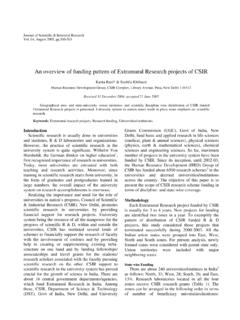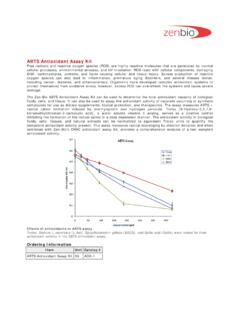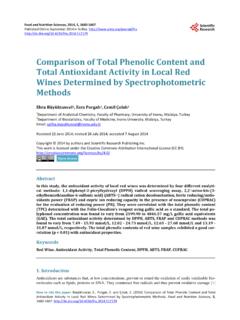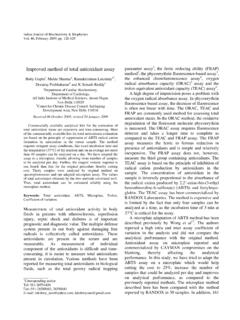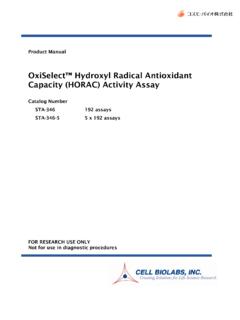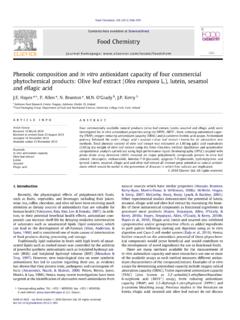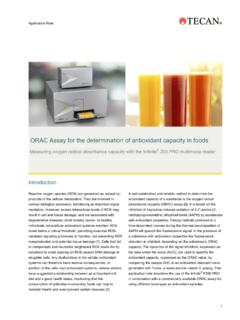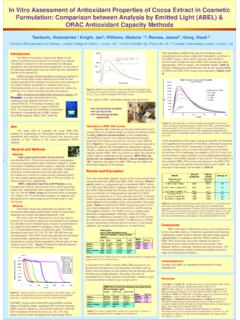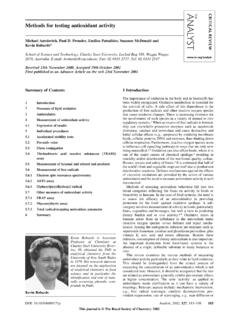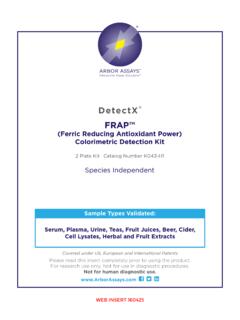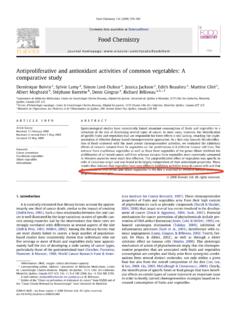Transcription of Comparison of DPPH and ABTS assays for determining ...
1 Indian Journal of Geo-Marine Sciences Vol. 42(5), September 2013, pp. 556-564 Comparison of DPPH and ABTS assays for determining antioxidant potential of water and methanol extracts of Spirulina platensis Emad A. Shalaby1 & Sanaa M. M. Shanab2 1 Biochemistry Department, Faculty of Agriculture, Cairo University, Giza, 2 Department of Botany, Faculty of Science, Cairo University, Giza, 1[ : Received 5 June 2012; revised 2 August 2012 Present research was to evaluate and compare the antiradical and antioxidant activities of extracts from Spirulina platensis. In the present study, three extracts (Water, absolute methanol and 50% methanol in water) were analyzed for the total phenolic compounds, phycobiliprotein content: Antiradical and antioxidant activities were evaluated using 2,2-diphenyl-1-picrylhydrazyl (DPPH ) and 2,2-azinobis (3-ethylbenzothiazoline-6-sulfonic acid) (ABTS) radical scavenging methods at 100 and 200 g/mL.]
2 Results revealed that, absolute methanol extract recorded the highest number of antiradical units 1 mg extract followed in descending order by that of water while the lowest number was that of aqueous methanol (against DPPH and ABTS radical methods) and these correlated with chemical constituents of extract from phenolic and phycobiliprotein compounds. It is elucidated that selection of the cyanobacterium (Spirulina platensis) very important for consumer s health, as it is considered as potential sources of dietary antioxidants . [Keywords: Spirulina platensis, Antioxidant, Antiradical, DPPH, ABTS, Phenolic compounds] Introduction Among several alga genera, Spirulina and Chlorella deserve special attention due to their importance as human food and their in vitro and/or in vivo antioxidant potential1.
3 Moreover, it contains other components such as -3 and -6 polyunsaturated fatty acid, provitamins and phenolic compounds. In addition, this alga can be cultivated in large-scale systems2. Polyphenols constitute a large group of naturally occurring substances in the plant kingdom, which include the flavonoids. Antioxidant property of phenolics is mainly due to their redox properties. They act as reducing agents (free radical terminators), hydrogen donors, singlet oxygen quenchers and metal chelators3. Evidence suggests that high intake of antioxidant nutrients from food sources offers health advantages4.
4 It should be emphasized that there is a great difference between antiradical and antioxidant activity and that they do not necessarily coincide. According to Tirzitis and Bartosz5 the antiradical activity characterizes the ability of compounds to react with free radicals (in a single free radical reaction), but antioxidant activity represents the ability to inhibit the process of oxidation (which usually, at least in the case of lipids, involves a set of different reactions). Consequently, all test systems using a stable free radical (for example, DPPH, ABTS, etc) give information on the radical scavenging or antiradical activity, although in many cases this activity does not correspond to the antioxidant activity.
5 In order to obtain information about the real antioxidant activity with respect to lipids or food stabilization, it is necessary to carry out the study on the real product (plant oil, lipoproteins, etc.). Numerous methods are used to evaluate antioxidant activities of natural compounds in foods or biological systems with varying results. Two free radicals that are commonly used to assess antioxidant activity in vitro are 2, 2-azinobis (3-ethylbenzothiazoline- 6-sulfonic acid) (ABTS) and 2, 2-diphenyl-1-picrylhydrazyl (DPPH). However, both of these radicals are foreign to biological systems. abts assay measures the relative ability of antioxidant to scavenge the ABTS generated in aqueous phase, as compared with a Trolox (water soluble vitamin E analogue) standard.
6 The ABTS is generated by reacting a strong oxidizing agent ( , potassium permanganate or potassium persulfate) with the ABTS salt. Reduction of blue-green ABTS radical colored solution by hydrogen-donating antioxidant is measured by the suppression of its characteristic long wave (734 nm) absorption spectrum6. _____ 1 Corresponding author SHALABY et al: ANTIOXIDANT POTENTIAL OF WATER AND METHANOL 557 DPPH is a stable free radical with an absorption band at 515 nm. It loses this absorption when reduced by an antioxidant or a free radical species. DPPH method is widely used to determine antiradical/ antioxidant activity of purified phenolic compounds as well as natural plant extracts7.
7 Bondet et found that most phenolic antioxidants react slowly with DPPH, reaching a steady state in 1-6 h or longer. This suggests that antioxidant activity using DPPH should be evaluated over time. The method also has good repeatability and is used frequently. However, like ABTS, it has limited, if any, relevance to biological systems. Also, color interference of DPPH with samples that contain anthocyanins leads to underestimation of antioxidant activity9. The ABTS method has the extra flexibility in that it can be used at different pH levels (unlike DPPH, which is sensitive to acidic pH) and thus is useful when studying the effect of pH on antioxidant activity of various compounds10.
8 It is also useful for measuring antioxidant activity of samples extracted in acidic solvents. Additionally, ABTS is soluble in aqueous and organic solvents and is thus useful in assessing antioxidant activity of samples in different media and is currently most commonly used in simulated serum ionic potential solution (pH phosphate buffer containing 150 mM NaCl) (PBS). Another advantage of ABTS method was that samples reacted rapidly with ABTS in the aqueous buffer solution reaching a steady state within 30 min. The DPPH reacted very slowly with the samples, approaching, but not reaching, steady state after 8 h.
9 This slow reaction was also observed when ABTS was reacted with samples in alcohol; implying that the reactivity of the antioxidants in sorghums with these free radicals is somehow slowed in alcoholic media. Brand-Williams et reported similar slow reaction of most antioxidants which were tested with the DPPH. The objective of this study was to compare the antiradical and antioxidant activities of alcoholic and aqueous extracts of Spirulina platenis using DPPH and ABTS radical methods. Materials and Methods Spirulina platensis was obtained from the Culture Collection of Botany Dept., Faculty of Science, Cairo University, Giza, Egypt.
10 Three methods of extraction were used I, II and III. Method I was used to extract raw materials. In this method, absolute methanol was used as the first solvent. In raw materials, flavonoids and phenolic acids, which are soluble in methanol, were recognized as the main phenolic fraction with antiradical activity. Method II was applied to extract raw materials with 50% methanol in water. In these raw materials, tannins were considered as the important fraction with antiradical activity. Tannins are insoluble in methanol, but well soluble in a mixture of methanol: water (1:1).



